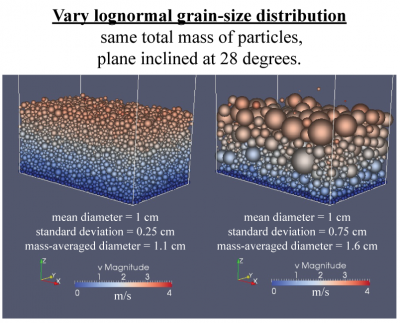HPCCprojects:Investigating controls on bedrock erosion by granular flows using an open source discrete element model
Project description
Although steep valleys are ubiquitous in mountainous terrain and there is evidence that episodic scour by debris flows is an important erosional process in these valleys, there is no agreed upon mechanical framework to describe debris flow incision into bedrock. Hence our goal is formulate a defensible stochastic debris flow incision rule.
We hypothesize that the rate of bedrock incision will scale with the product of the intensity at which flow particles impact the bedrock channel floor (measured as impact force or energy) and the impact flux. We use grain-scale numerical experiments (discrete element method simulations) of free-surface, gravity-driven granular flows to quantify how impact intensity and impact flux, and hence the rate at which debris flows incise bedrock, change as a function of field measureable channel and flow properties such as grain size, flow depth, and channel slope.

Probability density of basal normal impact force from simulated monodispersed flows decayed rapidly and in an exponential manner with increasing force magnitude. Only when monodispersed flows were replaced by broad grain size distributions, characteristic of natural debris flows, did the distributions of simulated impact forces have a similar form to those measured beneath the natural flows. These results highlight the important role flow grain size can have on basal impact force.
As either bed inclination or flow depth was increased in the simulated flows, the mean and the spread of the impact force and impact energy distribution increased as well and in a nonlinear fashion. Bed impact flux was largely decoupled from the downstream flux of particles and was a linearly decreasing function of slope once slope increased beyond a threshold value. Incision rate, which should scale as the product of impact energy and impact flux, increased as a nonlinear function of slope. Steep landscapes in which millennial scale erosion rates have been quantified display a similar nonlinear relationship between erosion rate and channel gradient. This suggests that the grain-scale mechanics quantified here could place strong controls on steepland morphology that evolves over thousands to millions of years.
Time-line
This project was part of my Ph.D., which is now finished. But new questions keep emerging so the project is ongoing.
Models in use
A modified version of the open source discrete element code called LIGGGHTS. http://cfdem.dcs-computing.com/?q=OpenSourceDEM
Users
Scott McCoy Greg Tucker
Funding
This research was supported by the National Science Foundation (NSF) Graduate Fellowship, and NSF grants EAR 0643240 and EAR 0952247.
Publications and presentations
McCoy, S. W. (2012), Controls on Erosion and Transport of Mass by Debris Flows, PhD dissertation, University of Colorado.
McCoy, S.W., G.E. Tucker, J. W. Kean, J. A. Coe (2012), Granular Mechanics of Debris-Flow Incision: Measuring and Modeling Grain-Scale Impact Forces, Abstract EP41C-0810, 2012 Fall Meeting, AGU, San Francisco.
McCoy, S. W., G. E. Tucker, A. C. Whittaker, S. T. Lancaster, G. P. Roberts, and P. A. Cowie (2010), Debris flows and landscape evolution: Insight from topographic analysis, millennial erosion rates and grain-scale flow mechanics, in Geophysical Research Abstracts, vol. 12, pp. EGU2010–7399–1.


